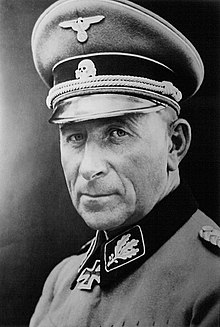Gruppenführer
Gruppenführer (literally “Group Leader”) was an early paramilitary rank of the Nazi Party, first created in 1925 as a senior rank of the SA.

SS rank
In 1930, Gruppenführer became an SS rank and was originally bestowed upon those officers who commanded SS-Gruppen and also upon senior officers of the SS command staff. In 1932, the SS was reorganized and the SS-Gruppen were reformed into SS-Abschnitt. Gruppenführer commanded the SS-Abschnitt while a new rank, that of Obergruppenführer, oversaw the SS-Oberabschnitts which were the largest SS units in Germany.
As in the SA, the SS rank of Gruppenführer was considered equivalent to a full General, but became regarded as equivalent to Generalleutnant after 1934. During the Second World War, when the Waffen-SS began using the rank, an SS-Gruppenführer was considered equal to a Generalleutnant in the Wehrmacht and was typically referred to as SS-Gruppenführer und Generalleutnant der Waffen-SS.
The insignia for SS-Gruppenführer consisted of three oak leaves centered on both collars of an SS uniform. From 1930 to 1942, the SS insignia was the same as the SA badge of rank; however the SS modified the Gruppenführer insignia slightly, to include an additional collar pip, upon the creation of the rank Oberstgruppenführer.
Waffen-SS Gruppenführer also displayed the shoulder boards of a Wehrmacht Generalleutnant.
SA rank
A Gruppenführer was typically in charge of large numbers of SA units (known as Standarten) which were formed into SA-Gruppen. Upon its original conception, Gruppenführer was considered equivalent to a full General.
Other uses
The rank of Gruppenführer was also used in several other Nazi paramilitary groups, among them the National Socialist Motor Corps (NSKK) and the National Socialist Flyers Corps (NSFK). In 1944, the rank of Gruppenführer was adopted by the Volkssturm as a low level non-commissioned officer position in charge of squad sized formations (Gruppe) of Volkssturm soldiers.
The term is also a generic term for the function of a leader of a squad of infantry (9 or 10 men - Gruppe) in the German Army, Waffen SS, or Luftwaffe ground troops.
In the German fire fighting corps, the term Gruppenführer refers to the commander of a group of eight fire fighters. A Gruppe is the smallest tactical unit in the German fire fighting corps. Just as in military use, the term does not refer to a rank but describes a function. The term is still in use today.
Kampfgruppe - a combat group made up for a particular purpose or in an emergency – size varied. Regimentsgruppe, Divisionsgruppe, Korpsgruppe - ad hoc formations of the size indicated by the title. Panzergruppe - one or more Armeekorps subordinate to an Infantry Army; later became independent as Panzerarmee Armeegruppe - occasionally an Army sized Combat Group usually much like a Korpsgruppe and also a temporary grouping of two Armies usually one German and one Allied Army. It is not to be confused with Heeresgruppe, which was the command of several Armies.| Junior Rank Brigadeführer |
SS rank and SA rank Gruppenführer |
Senior Rank Obergruppenführer |
